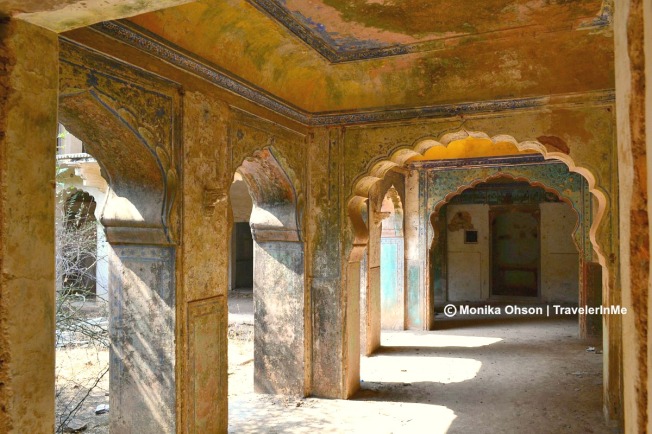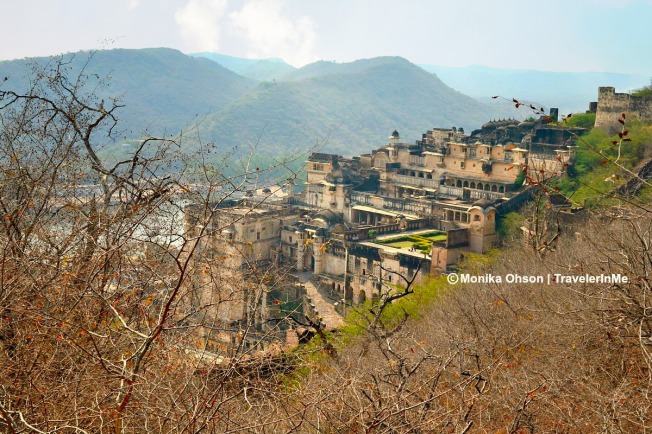
View of the fort complex from the Rani Mahal’s balcony
Taragarh Fort has a structure like a star (Tara’ means ‘Star’) and was constructed in 1354, by Rao Bar Singh. Unlike most forts (made of sandstone) it is built with serpentine stone (green colored) and is situated vertically on a steep hill side. It is considered to be one of the oldest forts in Rajasthan and has no elements of Mughal or any other architectural influence. It has seen many rulers like the Rajputs, Marathas, Mughals and many battles as well. The fort has another unique feature of many having tunnels built running across the hill. However, these are now inaccessible, one, due to lack of actual map and two, due to the miserable condition the fort is in.
Once we were through the beautiful Chitrashala we embarked on the steep climb to the top of the hill, to the Taragarh Fort. The guards at Chitrashala helped us refill our water bottles* and select solid sticks to keep the monkeys at bay and help in the trek.

The way to the Bundi Fort

Way to the fort: steep up hill climb, dry overgrown vegetation
Being a non trekker and not so fit I decided to take it slow with regular sips of water. The climb was steep** and like walking through a dry jungle with no signage! We met families of monkeys along the way and the sight & sound of stick kept them at bay.

The current inhabitants
The fort once described by Rudyard Kipling as “the work of Goblins than of men” is now home to several families of apes.

Dry, overgrown wild vegetation is a common sight
There are three massive gateways to the fort, Lakshmi Pol; Phuta Darwaza and Gagudi ki Phatak but sadly they are on their way to be ruins soon. The first one we came across was somehow holding itself together (probably Phuta Darwaza)

The first gate that leads to the fort from Chitrashala. Maybe Phuta Darwaza
Once inside the compound we wondered which way to go; whether the path we take has a dead end or is connected? Nevertheless we took a route that led us to some unidentified structures and a baori. We also came across some interesting flighty birds. Further up we were lost as it looked like a dead end!
We came back to the point we started and went on another route that led us to another fort entrance. The first solid structure we saw was that of Chota Jiv Rakha.

L-R: Maybe Lakshmi Pol; Gagudi ki Phatak from outside
Gagudi ki Phatak has a massive and very interesting lock. The only way in was through its small pedestrian gate.

Gagudi ki Phatak from inside. Look at the interesting gate lock!
We had heard about the 16th century bastion ‘Bhim Burj‘ where once upon a time a large cannon called ‘Garbh Gunjam‘ or ‘Thunder from the Womb‘ was mounted. The place was so isolated and unkempt that we really did not venture around too much or to the bastion.

View of the 16th century bastion ‘Bhim Burj’
The fort has many water reservoirs called baoris/stepwell carved out of the rocks. The water stored in them was used to supply during time of crisis & otherwise.

Taragarh or Dudha Mahal baori

Rani Mahal baori
There are a couple of, or maybe more, mahal (palaces) in the fort and a probable baradari. Had the place been maintained one would have had a better idea. At least a map of the fort with broad layout displayed somewhere or given as a handout combined with signage would be of great help to tourists.
Rani Mahal, is a small palace built for the wives and concubines of the kings.

Gate into Rani Mahal

Chota Jiv Rakha

Inside Chota Jiv Rakha
Taragarh or Dudha Mahal inside the fort which has beautiful fresco paintings. Its sad to see the walls and paintings fading and disfigured with writings and smudging

Fading paintings

This portion of the complex had colorful painting all over

Fresco paintings smudged and fading

One of the Mahals / palaces. Note the carving on the pillars and top skirting of the walls

Unkempt & uncared, Taragarh Fort’s probable baradari
There was a foreigner couple trying to figure out the fort but I guess they got panicky as there was no direction and vegetation growing wild. We helped them step out of the fort from where they were confident they could head back!

A portion of the fort complex

Inside the fort complex — portion of its mahals / palaces

L-R: Rani Mahal’s pretty balcony with arches ; Pillar carvings
The fort being on top of the hill offers fantastic view of the Bundi City; Garh Palace and lakes. We rested for a while enjoying the view from the top before the downhill descent. We were soon joined by a lone traveler who seemed to be enjoying the view and the solace the place offered in plenty!

Fantastic view of the Bundi Palace; blue city of ‘Bundi’ ; Nawal Sagar/Lake from the fort

View of Garh Palace & Chitrashala from further up the hill, enroute Taragarh Fort
Except for Chitrashala, the Garh/Bundi Palace and Taragarh/Bundi Fort are still under the control of the erstwhile Royal family of Bundi. Lack of fund or disinterest seems to be the reason for them being neglected. Garh Palace seems to be somewhat kempt as its the entry to the entire complex; Chitrashala is the most maintained and under ASI; Taragarh Fort is the forgotten, crumbling heritage. I hope the entire Palace & Fort complex is given to a body that works on restoring and maintaining of heritage!
*Please note and carry sufficient water for self when touring the Taragarh Fort & Palace as the place does not have provision
**Be careful when walking down from the fort. The rough , cobbled path is quite slippery and difficult to walk down and it being steep does not help much!
Read more about my Bundi Trip
The Hidden Jewel of Rajasthan, Blue City Bundi!
Stay @Bundi Haveli –Traditional yet contemporary
Visit to the Bhimlat Prehistoric Rock Painting Site @Bundi
Also read about the unexplored Jhalawar
Unexplored Rajasthan: Jhalawar
….and, if you like what you just read, do ‘like it’ & ‘share it’. Non WordPress users please ‘rate’ it to express your appreciation 🙂 Also do not forget to ‘follow the blog’ to remain updated about newer posts ❤
HAPPY TRAVELLING!
Monika Ohson | TravelerInMe
P.S. I had to do a lot of reference work to be able to identify portions of the fort complex. Unfortunately there is nothing concrete so I have used the word ‘probable’ & ‘maybe’ frequently. If anyone for sure knows the fort can help correct wherever erred. Though I hope the photographs will help visualize the fort & its complex!
Pingback: Visit to the Bhimlat Prehistoric Rock Painting Site @Bundi | TravelerInMe
Wonderful post! Your pics are so beautiful; captures the essence and spirit of the place wonderfully:)
LikeLiked by 1 person
Thank you Rashmi 🙂 Good to see you here !
LikeLike
Perhaps the most elaborate account in terms of photographs of this forlorn part of Bundi. Brought back many memories of my explorations too.
Shubham
LikeLiked by 1 person
Thank you 🙏 ☺ Shubham. Thats a really generous appreciation. Isn’t Bundi an interesting place? We clubbed Jhalawar with it….. unexplored gem of Rajasthan
LikeLiked by 1 person
My pleasure. Yes, Bundi is magic – all the way! I have heard great things about Jhalawar and Jhalrapatan from my dad. Its high time I explore Rajasthan too!
LikeLiked by 1 person
Magnificent place.Looks rather desolate. Glad to see no graffiti which is the bane of many of the heritage sites.
LikeLiked by 1 person
Glad to hear from you after long 🙂 Yes the place is too quiet and kind of abandoned. Oh there are name scribbled here and there! Maybe not seen in the photos shared. Despite all these low downs the fort like you mentioned is magnificent ……. only needs a good caretaker!
LikeLiked by 1 person
Can’t agree more.
LikeLiked by 1 person
I have been to Bundi but didn’t venture out to the fort as it was very short trip. Probably someday I will revisit for the views.
LikeLiked by 1 person
Ah! Yes the views are wonderful…… And hopefully the Fort is in a better shape, who knows 😄
LikeLiked by 1 person
True. 😊
LikeLike
I would say the calmness at the place is a benefit for travelers. Many famous forts have too much activity going around that it is difficult to feel the place.
The only thing I would have loved (and you mentioned too) is to have a proper map and directions to the buildings there.
Somehow, I can’t help myself thinking that once a bustling fort is now nothing than a ruin (or leading to one)!
LikeLiked by 1 person
The place is certainly peaceful but then isolated too. I was very disheartened to see its condition and that beside us there was a frightened couple and a lone traveler only. I hope the custodians of the fort either do something for the upkeep or hand it over to someone who can.
Thank you Alok for stopping by and sharing your views too!
LikeLiked by 1 person
In India it is difficult to maintain such sites unless they are revenue generating (like Taj Mahal). So, such historic sites die a slow death, however saddening it might be.
LikeLiked by 1 person
Bundi has a good international tourist influx. The Bundi Garh Palace & ASI maintained Chitrashala (on the same Hill) see a lot of visitors…… Most don’t climb up further to the fort knowing its condition and local folks not encouraging much either.
Though what you state is a valid fact too!
LikeLiked by 1 person
The fort’s architecture is a bit different from other traditional ones we find in Rajasthan. The shape of ‘star’ perhaps made it…
The road to the fort looks alluring…beautiful pictures and, Kipling’s quote is amazing!
LikeLiked by 1 person
Thank you 🙏 ☺ Maniparna! Yes the architecture is purely Rajput and has its own uniqueness. Rajasthan is full of forts and each one leaves its own impression. Have you seen quite a bit of Rajasthan?
LikeLike
Pingback: The Hidden Jewel of Rajasthan, Blue City Bundi! | TravelerInMe